TOYOTA C-HR 2022 Owners Manual
Manufacturer: TOYOTA, Model Year: 2022, Model line: C-HR, Model: TOYOTA C-HR 2022Pages: 818, PDF Size: 113.75 MB
Page 301 of 818
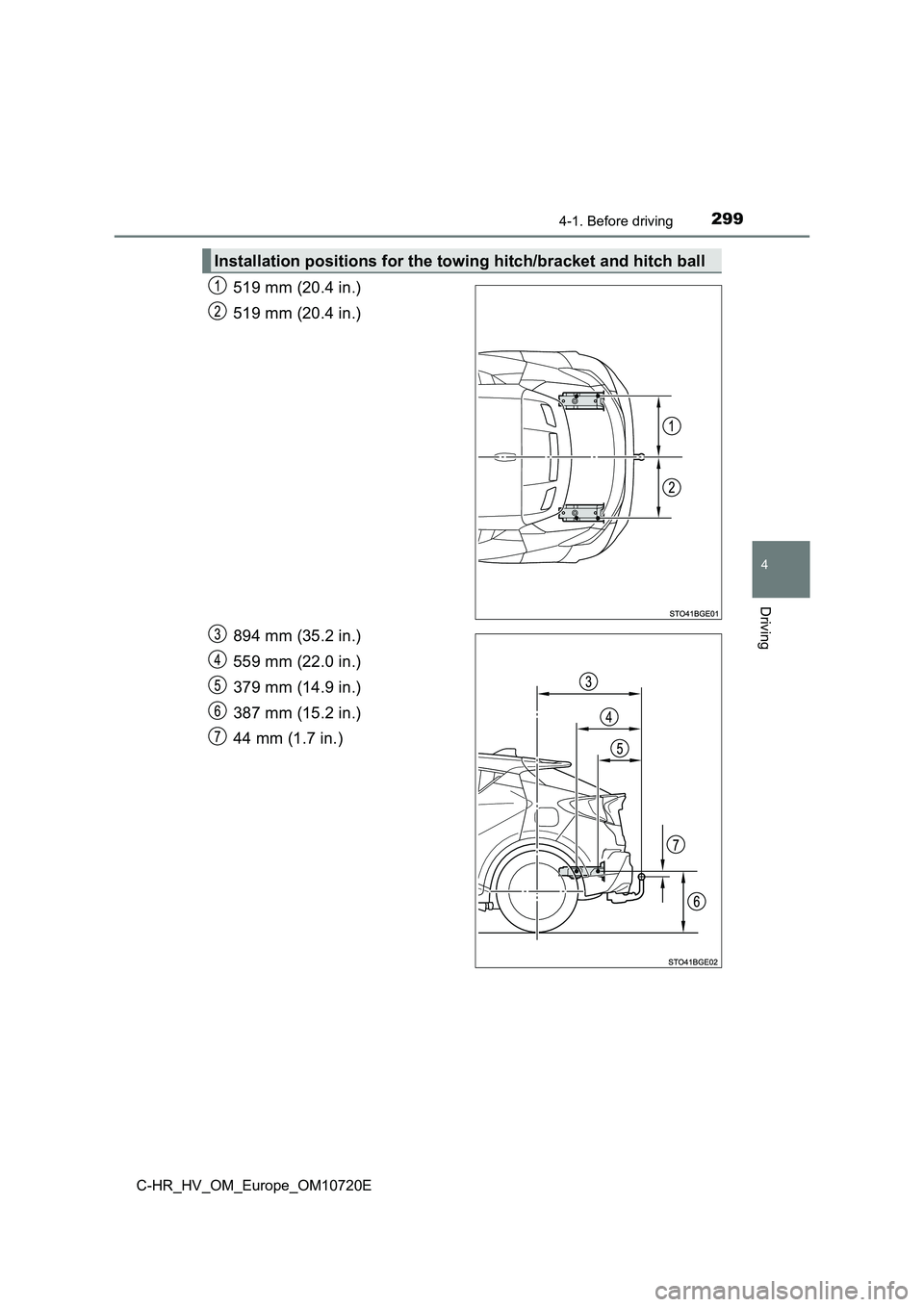
2994-1. Before driving
4
Driving
C-HR_HV_OM_Europe_OM10720E
519 mm (20.4 in.)
519 mm (20.4 in.)
894 mm (35.2 in.)
559 mm (22.0 in.)
379 mm (14.9 in.)
387 mm (15.2 in.)
44 mm (1.7 in.)
Installation positions for the towing hitch/bracket and hitch b all
Page 302 of 818
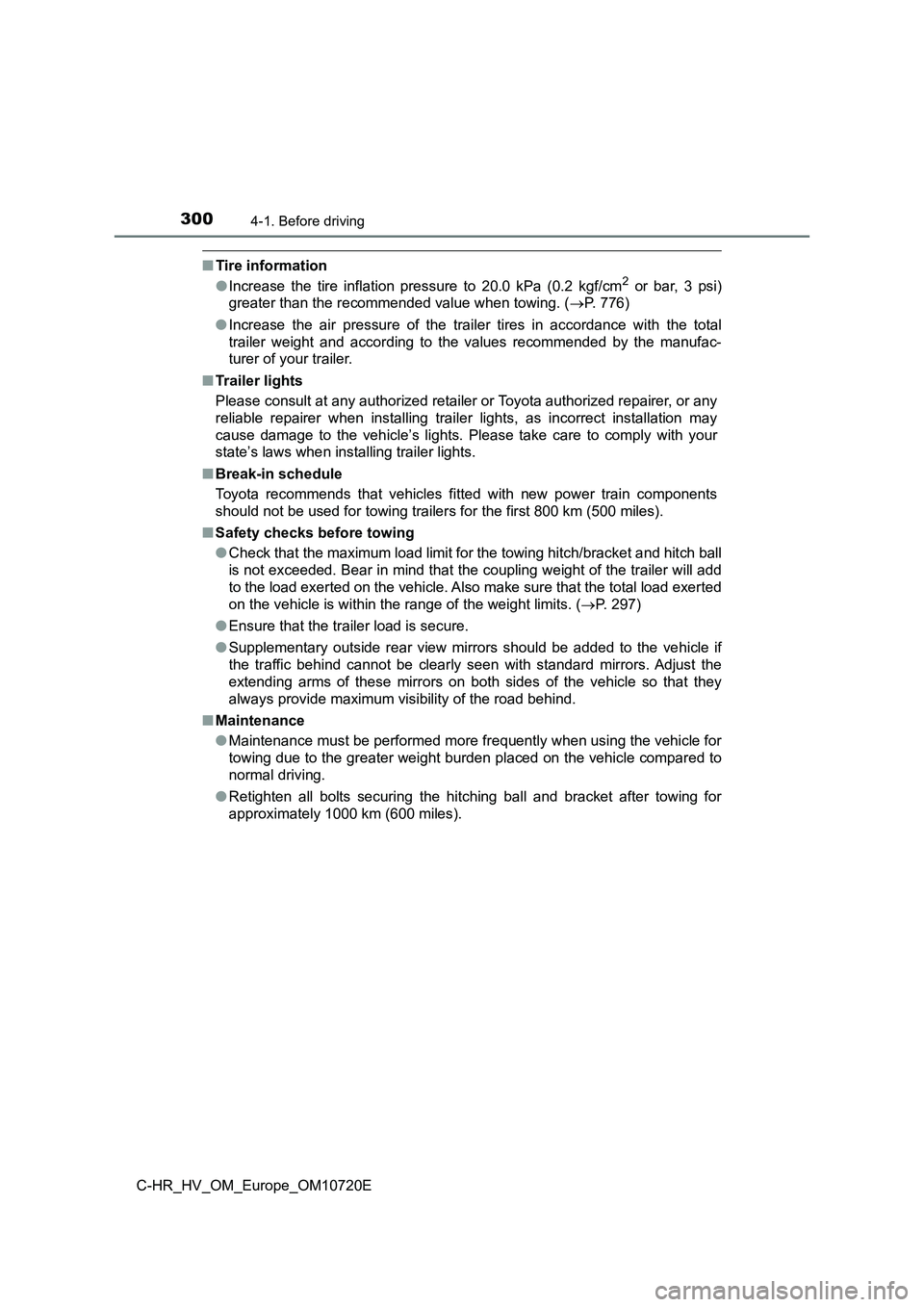
3004-1. Before driving
C-HR_HV_OM_Europe_OM10720E
■Tire information
● Increase the tire inflation pressure to 20.0 kPa (0.2 kgf/cm2 or bar, 3 psi)
greater than the recommended value when towing. ( P. 776)
● Increase the air pressure of the trailer tires in accordance with the total
trailer weight and according to the values recommended by the m anufac-
turer of your trailer.
■ Trailer lights
Please consult at any authorized retailer or Toyota authorized repairer, or any
reliable repairer when installing trailer lights, as incorrect installation may
cause damage to the vehicle’s lights. Please take care to compl y with your
state’s laws when installing trailer lights.
■ Break-in schedule
Toyota recommends that vehicles fitted with new power train com ponents
should not be used for towing trailers for the first 800 km (50 0 miles).
■ Safety checks before towing
● Check that the maximum load limit for the towing hitch/bracket and hitch ball
is not exceeded. Bear in mind that the coupling weight of the t railer will add
to the load exerted on the vehicle. Also make sure that the tot al load exerted
on the vehicle is within the range of the weight limits. ( P. 297)
● Ensure that the trailer load is secure.
● Supplementary outside rear view mirrors should be added to the vehicle if
the traffic behind cannot be clearly seen with standard mirrors . Adjust the
extending arms of these mirrors on both sides of the vehicle so that they
always provide maximum visibility of the road behind.
■ Maintenance
● Maintenance must be performed more frequently when using the vehicle for
towing due to the greater weight burden placed on the vehicle c ompared to
normal driving.
● Retighten all bolts securing the hitching ball and bracket after towing for
approximately 1000 km (600 miles).
Page 303 of 818
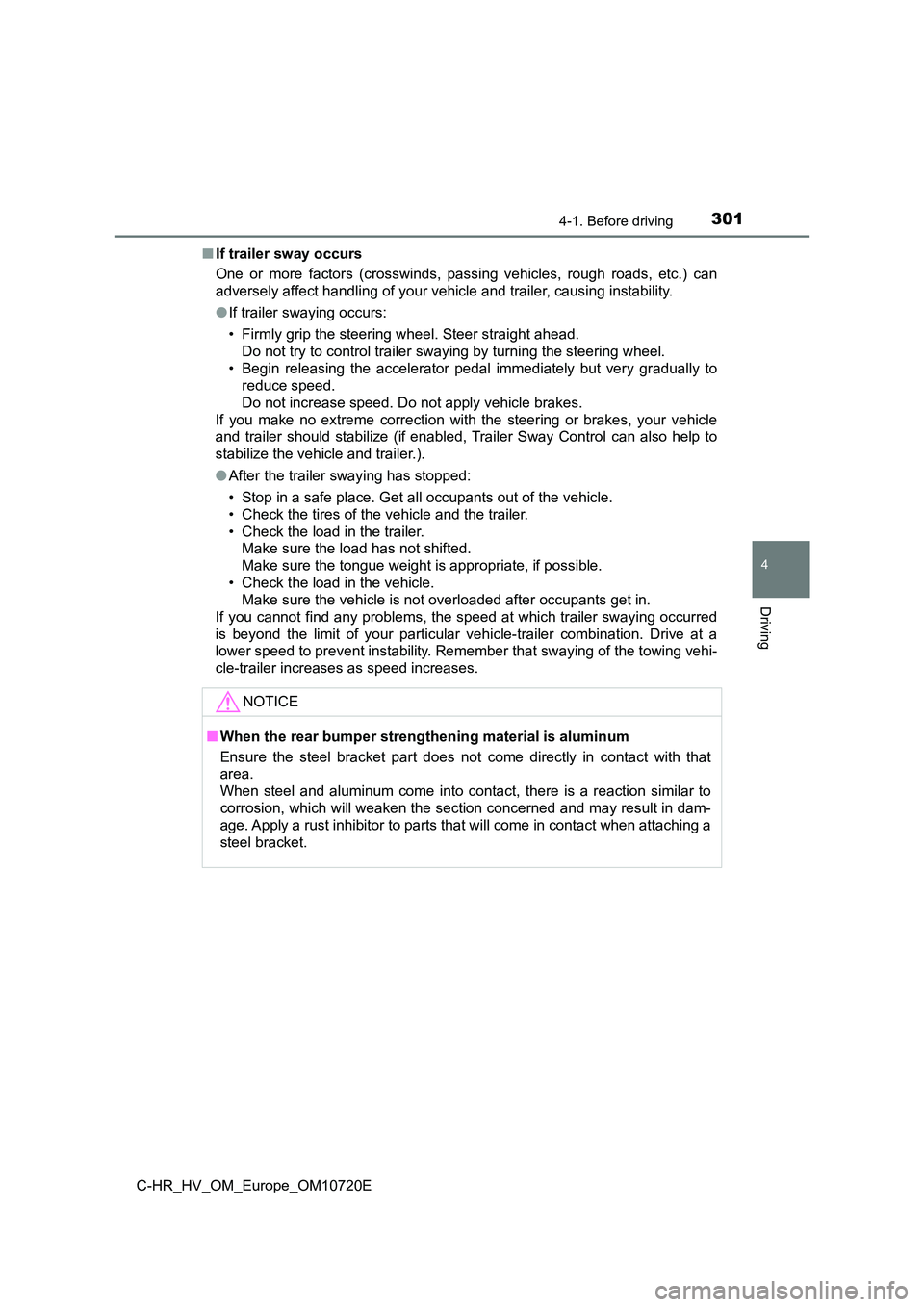
3014-1. Before driving
4
Driving
C-HR_HV_OM_Europe_OM10720E
■ If trailer sway occurs
One or more factors (crosswinds, passing vehicles, rough roads, etc.) can
adversely affect handling of your vehicle and trailer, causing instability.
● If trailer swaying occurs:
• Firmly grip the steering wheel. Steer straight ahead.
Do not try to control trailer swaying by turning the steering w heel.
• Begin releasing the accelerator pedal immediately but very gra dually to
reduce speed.
Do not increase speed. Do not apply vehicle brakes.
If you make no extreme correction with the steering or brakes, your vehicle
and trailer should stabilize (if enabled, Trailer Sway Control can also help to
stabilize the vehicle and trailer.).
● After the trailer swaying has stopped:
• Stop in a safe place. Get all occupants out of the vehicle.
• Check the tires of the vehicle and the trailer.
• Check the load in the trailer.
Make sure the load has not shifted.
Make sure the tongue weight is appropriate, if possible.
• Check the load in the vehicle.
Make sure the vehicle is not overloaded after occupants get in.
If you cannot find any problems, the speed at which trailer swa ying occurred
is beyond the limit of your particular vehicle-trailer combinat ion. Drive at a
lower speed to prevent instability. Remember that swaying of th e towing vehi-
cle-trailer increases as speed increases.
NOTICE
■ When the rear bumper strengthening material is aluminum
Ensure the steel bracket part does not come directly in contact with that
area.
When steel and aluminum come into contact, there is a reaction similar to
corrosion, which will weaken the section concerned and may resu lt in dam-
age. Apply a rust inhibitor to parts that will come in contact when attaching a
steel bracket.
Page 304 of 818
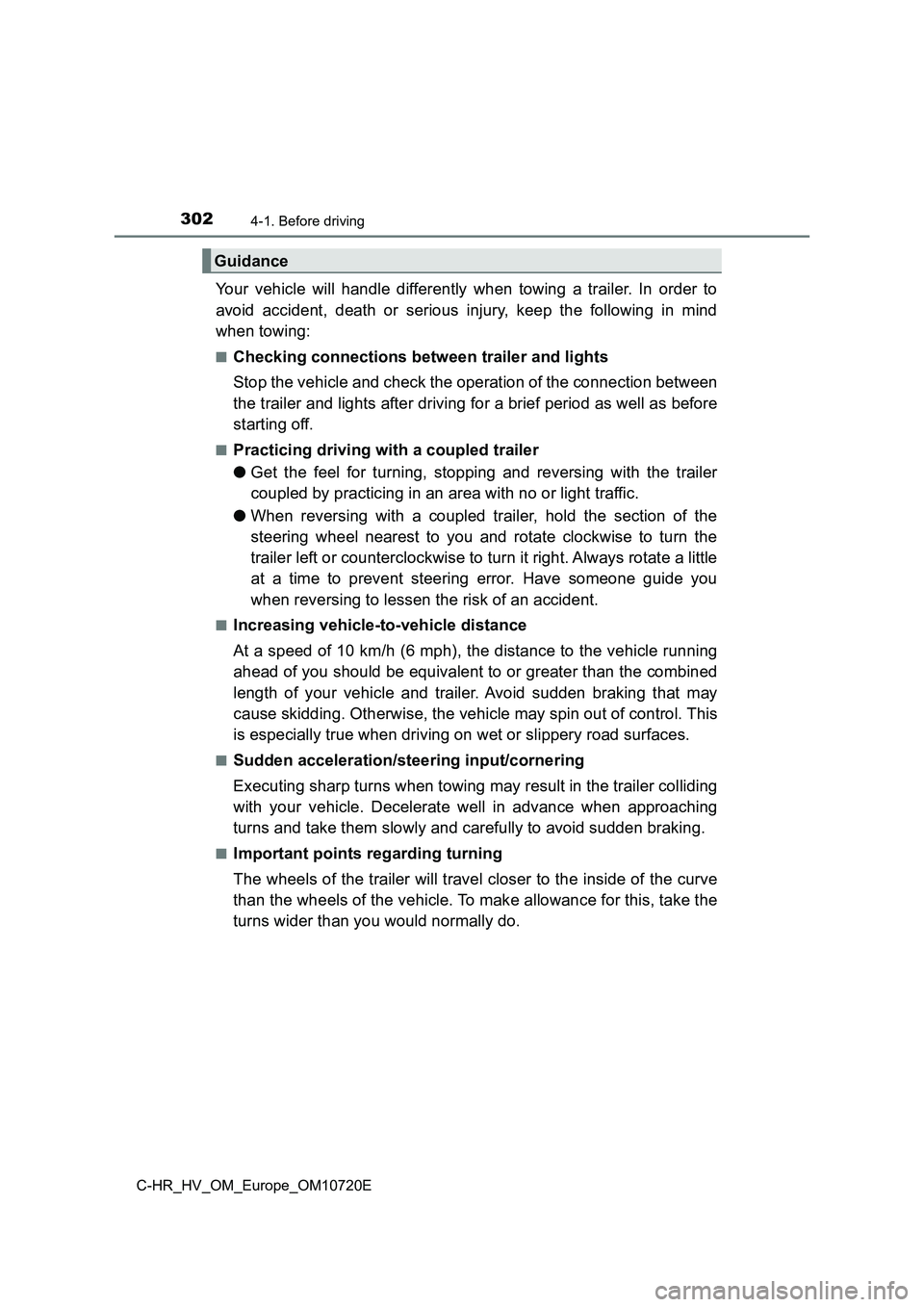
3024-1. Before driving
C-HR_HV_OM_Europe_OM10720E
Your vehicle will handle differently when towing a trailer. In order to
avoid accident, death or serious injury, keep the following in mind
when towing:
■Checking connections between trailer and lights
Stop the vehicle and check the operation of the connection betw een
the trailer and lights after driving for a brief period as well as before
starting off.
■Practicing driving with a coupled trailer
● Get the feel for turning, stopping and reversing with the trailer
coupled by practicing in an area with no or light traffic.
● When reversing with a coupled trailer, hold the section of the
steering wheel nearest to you and rotate clockwise to turn the
trailer left or counterclockwise to turn it right. Always rotat e a little
at a time to prevent steering error. Have someone guide you
when reversing to lessen the risk of an accident.
■Increasing vehicle-to-vehicle distance
At a speed of 10 km/h (6 mph), the distance to the vehicle runn ing
ahead of you should be equivalent to or greater than the combin ed
length of your vehicle and trailer. Avoid sudden braking that m ay
cause skidding. Otherwise, the vehicle may spin out of control. This
is especially true when driving on wet or slippery road surface s.
■Sudden acceleration/steering input/cornering
Executing sharp turns when towing may result in the trailer col liding
with your vehicle. Decelerate well in advance when approaching
turns and take them slowly and carefully to avoid sudden brakin g.
■Important points regarding turning
The wheels of the trailer will travel closer to the inside of t he curve
than the wheels of the vehicle. To make allowance for this, tak e the
turns wider than you would normally do.
Guidance
Page 305 of 818
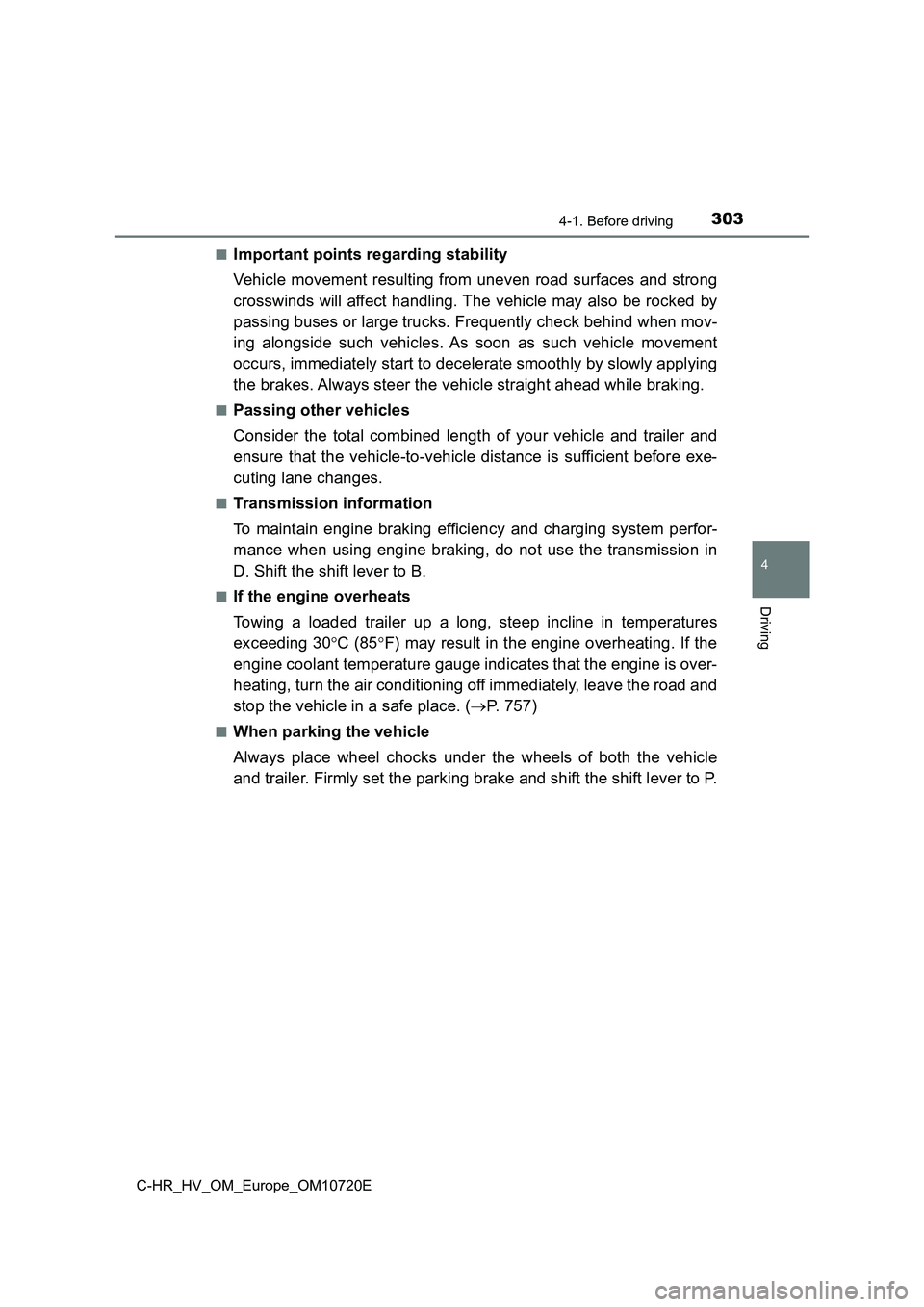
3034-1. Before driving
4
Driving
C-HR_HV_OM_Europe_OM10720E
■Important points regarding stability
Vehicle movement resulting from uneven road surfaces and strong
crosswinds will affect handling. The vehicle may also be rocked by
passing buses or large trucks. Frequently check behind when mov -
ing alongside such vehicles. As soon as such vehicle movement
occurs, immediately start to decelerate smoothly by slowly appl ying
the brakes. Always steer the vehicle straight ahead while braki ng.
■Passing other vehicles
Consider the total combined length of your vehicle and trailer and
ensure that the vehicle-to-vehicle distance is sufficient befor e exe-
cuting lane changes.
■Transmission information
To maintain engine braking efficiency and charging system perfo r-
mance when using engine braking, do not use the transmission in
D. Shift the shift lever to B.
■If the engine overheats
Towing a loaded trailer up a long, steep incline in temperature s
exceeding 30 C (85F) may result in the engine overheating. If the
engine coolant temperature gauge indicates that the engine is o ver-
heating, turn the air conditioning off immediately, leave the r oad and
stop the vehicle in a safe place. ( P. 757)
■When parking the vehicle
Always place wheel chocks under the wheels of both the vehicle
and trailer. Firmly set the parking brake and shift the shift l ever to P.
Page 306 of 818
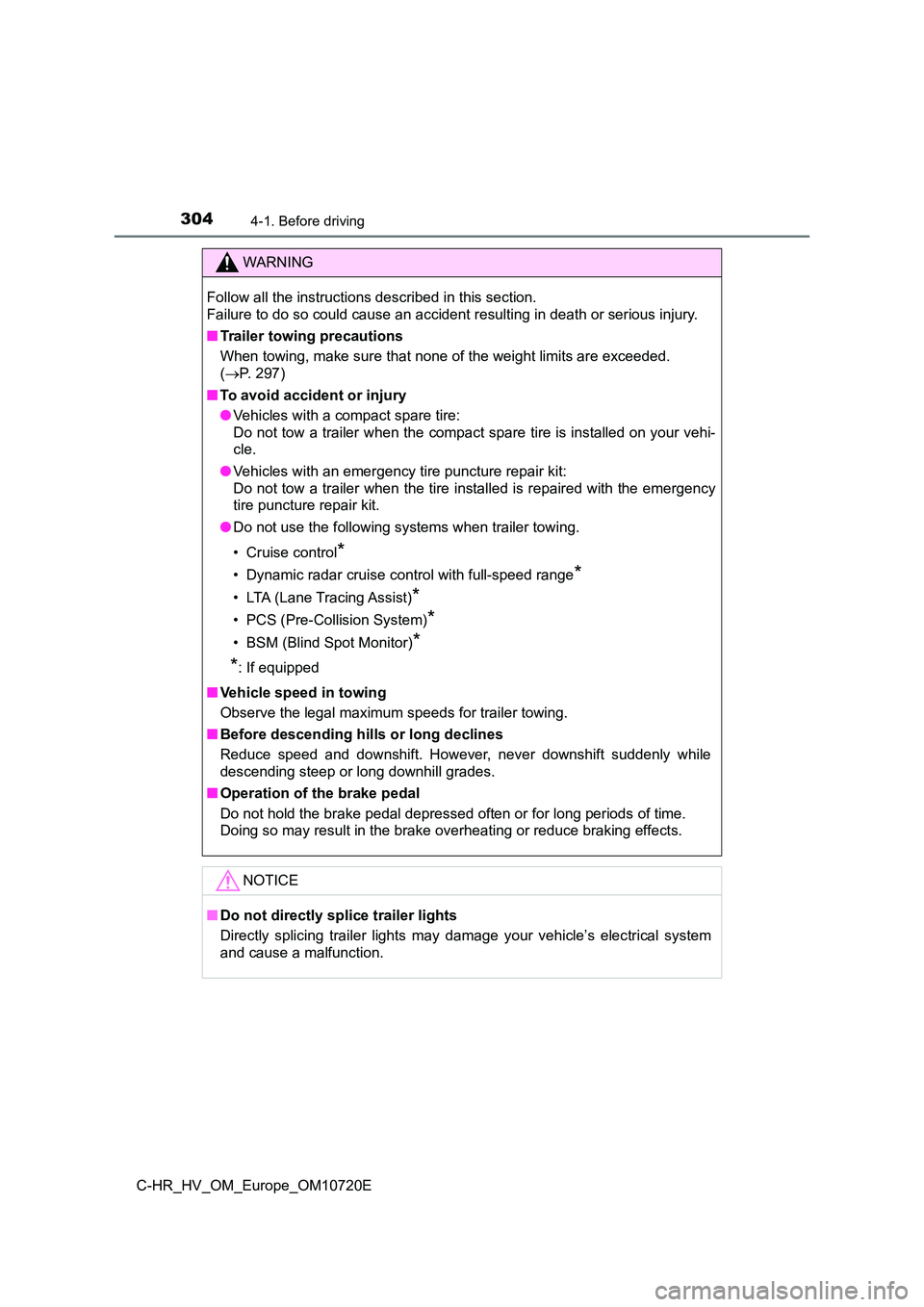
3044-1. Before driving
C-HR_HV_OM_Europe_OM10720E
WARNING
Follow all the instructions described in this section.
Failure to do so could cause an accident resulting in death or serious injury.
■ Trailer towing precautions
When towing, make sure that none of the weight limits are excee ded.
( P. 297)
■ To avoid accident or injury
● Vehicles with a compact spare tire:
Do not tow a trailer when the compact spare tire is installed o n your vehi-
cle.
● Vehicles with an emergency tire puncture repair kit:
Do not tow a trailer when the tire installed is repaired with t he emergency
tire puncture repair kit.
● Do not use the following systems when trailer towing.
• Cruise control*
• Dynamic radar cruise control with full-speed range*
• LTA (Lane Tracing Assist)*
• PCS (Pre-Collision System)*
• BSM (Blind Spot Monitor)*
*: If equipped
■ Vehicle speed in towing
Observe the legal maximum speeds for trailer towing.
■ Before descending hills or long declines
Reduce speed and downshift. However, never downshift suddenly w hile
descending steep or long downhill grades.
■ Operation of the brake pedal
Do not hold the brake pedal depressed often or for long periods of time.
Doing so may result in the brake overheating or reduce braking effects.
NOTICE
■Do not directly splice trailer lights
Directly splicing trailer lights may damage your vehicle’s elec trical system
and cause a malfunction.
Page 307 of 818
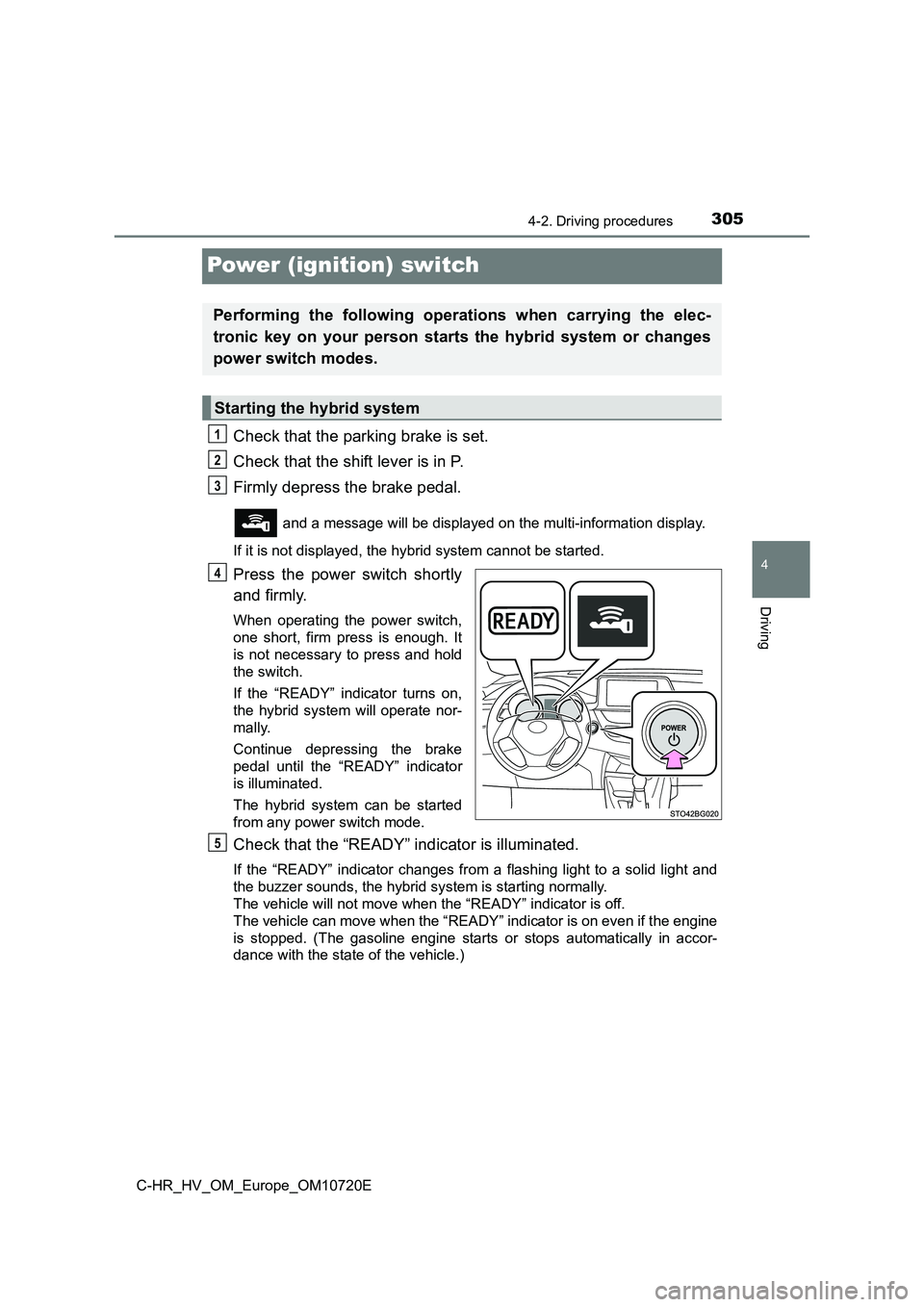
305
4
4-2. Driving procedures
Driving
C-HR_HV_OM_Europe_OM10720E
Power (ignition) switch
Check that the parking brake is set.
Check that the shift lever is in P.
Firmly depress the brake pedal.
and a message will be displayed on the multi-information displ ay.
If it is not displayed, the hybrid system cannot be started.
Press the power switch shortly
and firmly.
When operating the power switch,
one short, firm press is enough. It
is not necessary to press and hold
the switch.
If the “READY” indicator turns on,
the hybrid system will operate nor-
mally.
Continue depressing the brake
pedal until the “READY” indicator
is illuminated.
The hybrid system can be started
from any power switch mode.
Check that the “READY” indicator is illuminated.
If the “READY” indicator changes from a flashing light to a sol id light and
the buzzer sounds, the hybrid system is starting normally.
The vehicle will not move when the “READY” indicator is off.
The vehicle can move when the “READY” indicator is on even if t he engine
is stopped. (The gasoline engine starts or stops automatically in accor-
dance with the state of the vehicle.)
Performing the following operations when carrying the elec-
tronic key on your person starts the hybrid system or changes
power switch modes.
Starting the hybrid system
1
2
3
4
5
Page 308 of 818
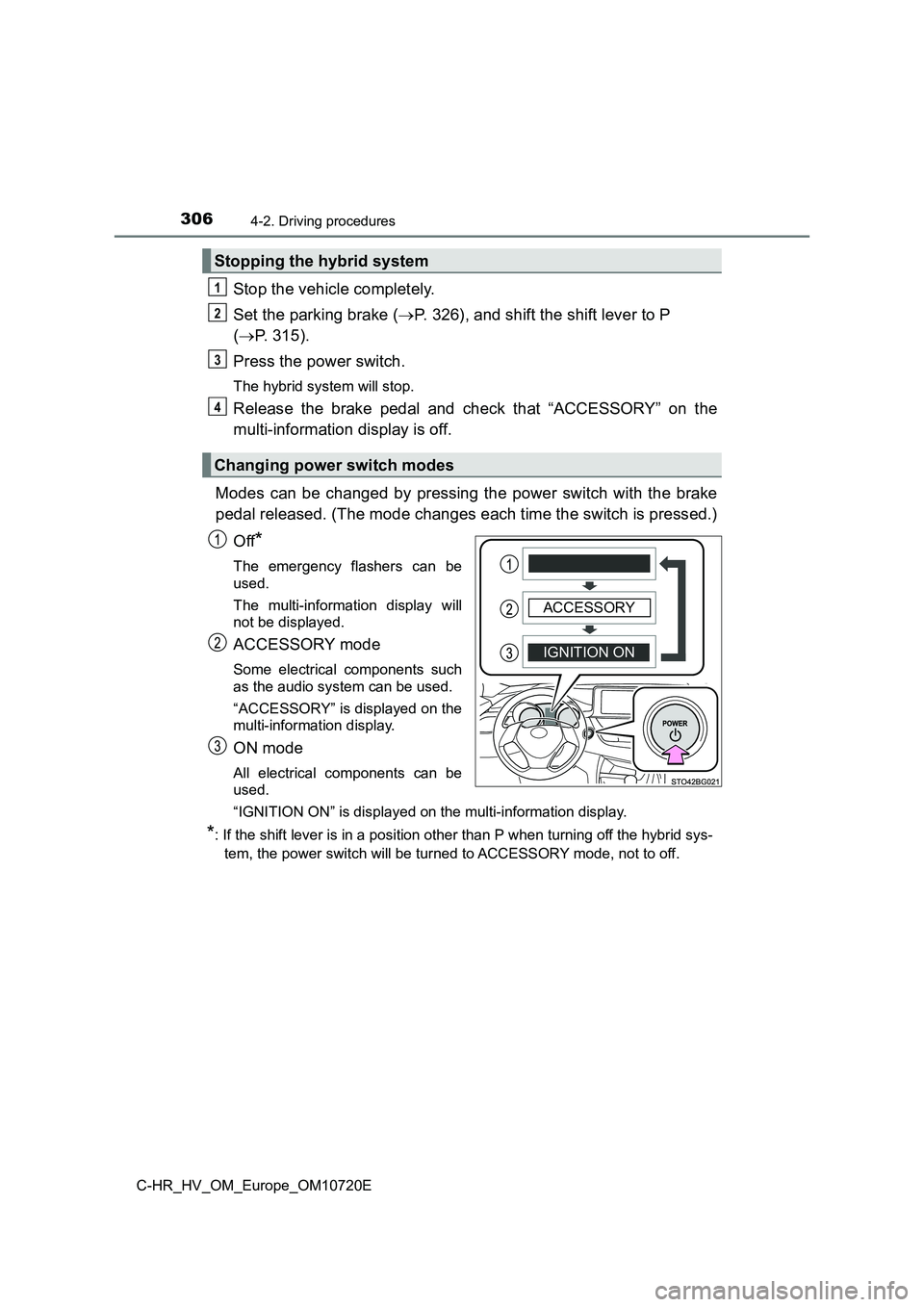
3064-2. Driving procedures
C-HR_HV_OM_Europe_OM10720E
Stop the vehicle completely.
Set the parking brake ( P. 326), and shift the shift lever to P
( P. 315).
Press the power switch.
The hybrid system will stop.
Release the brake pedal and check that “ACCESSORY” on the
multi-information display is off.
Modes can be changed by pressing the power switch with the brak e
pedal released. (The mode changes each time the switch is press ed.)
Off*
The emergency flashers can be
used.
The multi-information display will
not be displayed.
ACCESSORY mode
Some electrical components such
as the audio system can be used.
“ACCESSORY” is displayed on the
multi-information display.
ON mode
All electrical components can be
used.
“IGNITION ON” is displayed on the multi-information display.
*: If the shift lever is in a position other than P when turning off the hybrid sys-
tem, the power switch will be turned to ACCESSORY mode, not to off.
Stopping the hybrid system
Changing power switch modes
1
2
3
4
IGNITION ON
ACCESSORY
Page 309 of 818
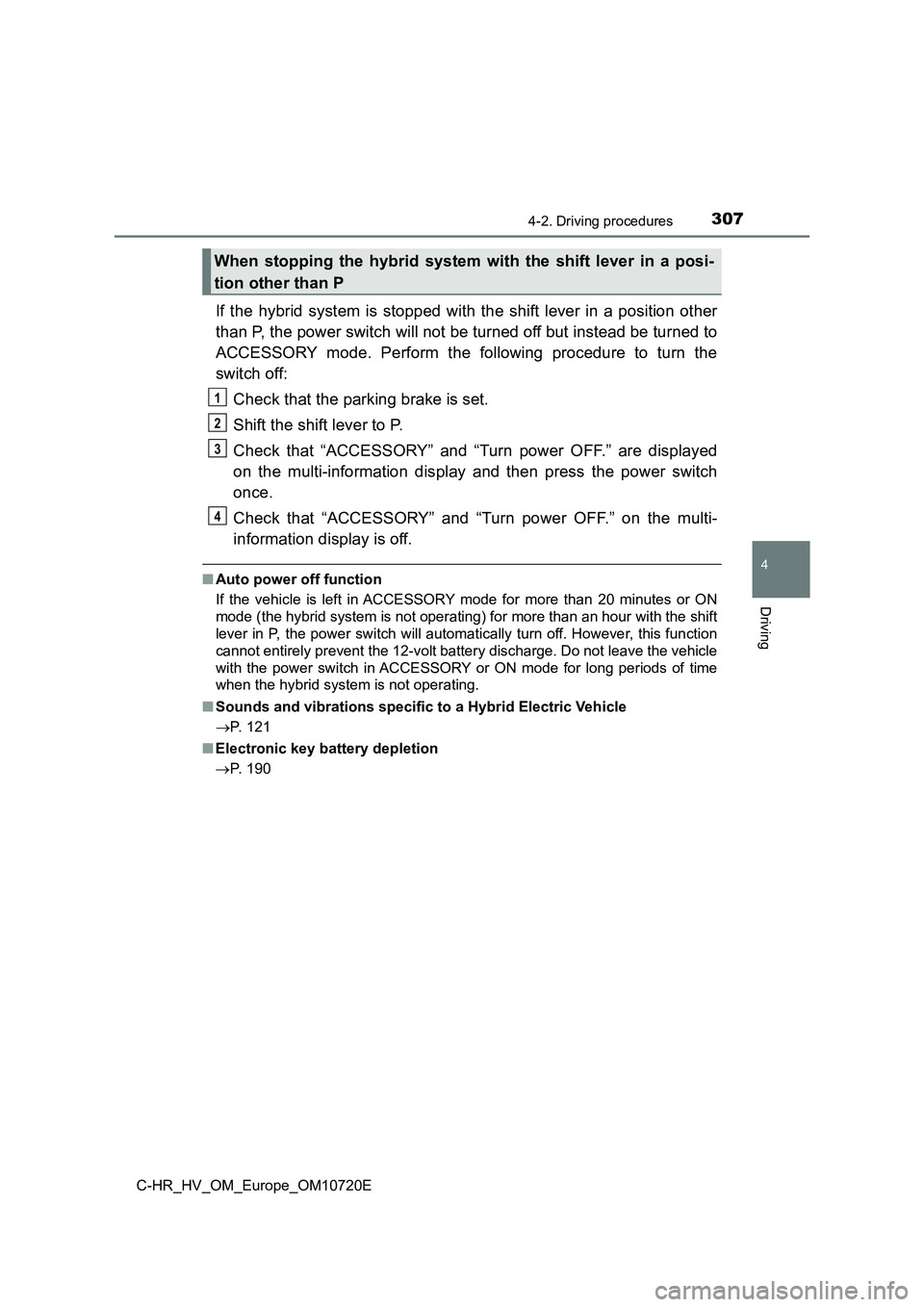
3074-2. Driving procedures
4
Driving
C-HR_HV_OM_Europe_OM10720E
If the hybrid system is stopped with the shift lever in a position other
than P, the power switch will not be turned off but instead be turned to
ACCESSORY mode. Perform the following procedure to turn the
switch off:
Check that the parking brake is set.
Shift the shift lever to P.
Check that “ACCESSORY” and “Turn power OFF.” are displayed
on the multi-information display and then press the power switc h
once.
Check that “ACCESSORY” and “Turn power OFF.” on the multi-
information display is off.
■ Auto power off function
If the vehicle is left in ACCESSORY mode for more than 20 minut es or ON
mode (the hybrid system is not operating) for more than an hour with the shift
lever in P, the power switch will automatically turn off. Howev er, this function
cannot entirely prevent the 12-volt battery discharge. Do not l eave the vehicle
with the power switch in ACCESSO RY or ON mode for long periods of time
when the hybrid system is not operating.
■ Sounds and vibrations specific to a Hybrid Electric Vehicle
P. 121
■ Electronic key battery depletion
P. 190
When stopping the hybrid system with the shift lever in a posi-
tion other than P
1
2
3
4
Page 310 of 818

3084-2. Driving procedures
C-HR_HV_OM_Europe_OM10720E
■ When the ambient temperature is low, such as during winter driving con-
ditions
When starting the hybrid system, the flashing time of the “READ Y” indicator
may be long. Leave the vehicle as it is until the “READY” indic ator is steady
on, as steady means the vehicle is able to move.
■ Conditions affecting operation
P. 210
■ Note for the entry function
P. 211
■ If the hybrid system does not start
● The immobilizer system may not have been deactivated. (P. 130)
Contact any authorized Toyota retailer or Toyota authorized rep airer, or any
reliable repairer.
● Check that the shift lever is securely set in P. The hybrid system may not
start if the shift lever is displaced out of P.
“Shift to P Position to Start.” will be displayed on the multi- information dis-
play.
■ Steering lock
After turning the power switc h off and opening and closing the doors, the
steering wheel will be locked due to the steering lock function . Operating the
power switch again automatically cancels the steering lock.
■ When the steering lock cannot be released
“Push POWER Switch while Turning The
Steering Wheel in Either Direction.” will be
displayed on the multi-information display.
Check that the shift lever is set in P. Press
the power switch while turning the steer-
ing wheel left and right.